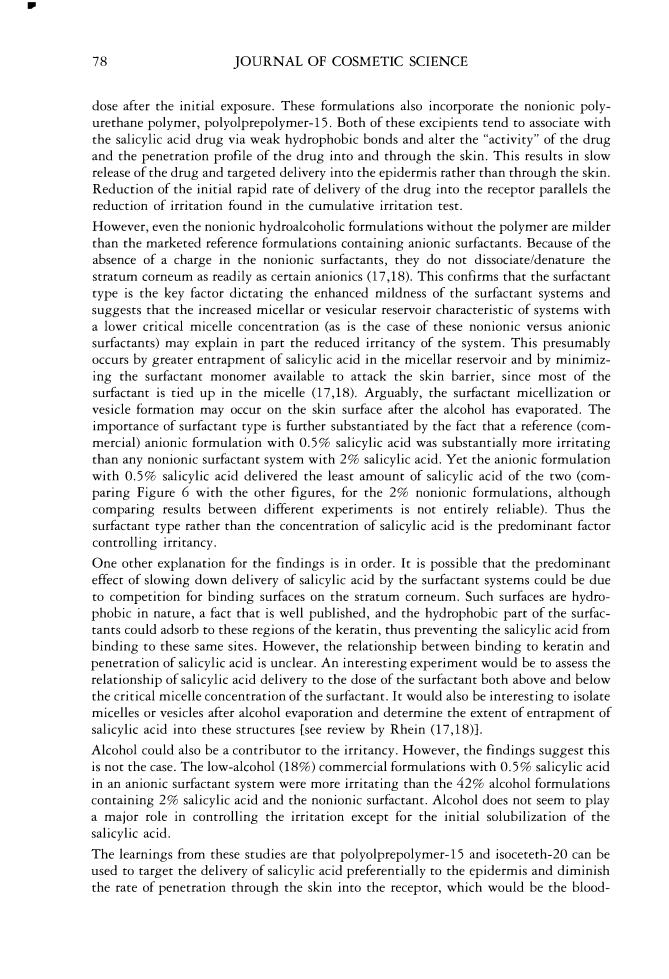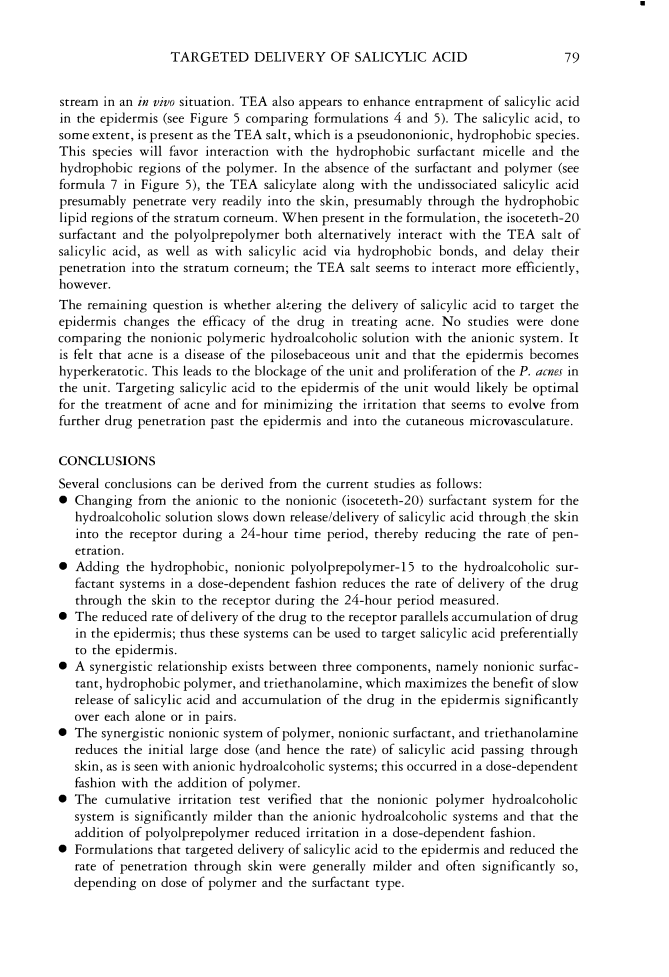78 JOURNAL OF COSMETIC SCIENCE dose after the initial exposure. These formulations also incorporate the nonionic poly urethane polymer, polyolprepolymer-15. Both of these excipients tend to associate with the salicylic acid drug via weak hydrophobic bonds and alter the "activity" of the drug and the penetration profile of the drug into and through the skin. This results in slow release of the drug and targeted delivery into the epidermis rather than through the skin. Reduction of the initial rapid rate of delivery of the drug into the receptor parallels the reduction of irritation found in the cumulative irritation test. However, even the nonionic hydroalcoholic formulations without the polymer are milder than the marketed reference formulations containing anionic surfactants. Because of the absence of a charge in the nonionic surfactants, they do not dissociate/denature the stratum corneum as readily as certain anionics (17,18). This confirms that the surfactant type is the key factor dictating the enhanced mildness of the surfactant systems and suggests that the increased micellar or vesicular reservoir characteristic of systems with a lower critical micelle concentration (as is the case of these nonionic versus anionic surfactants) may explain in part the reduced irritancy of the system. This presumably occurs by greater entrapment of salicylic acid in the micellar reservoir and by minimiz ing the surfactant monomer available to attack the skin barrier, since most of the surfactant is tied up in the micelle (17,18). Arguably, the surfactant micellization or vesicle formation may occur on the skin surface after the alcohol has evaporated. The importance of surfactant type is further substantiated by the fact that a reference (com mercial) anionic formulation with 0.5% salicylic acid was substantially more irritating than any nonionic surfactant system with 2% salicylic acid. Yet the anionic formulation with 0.5% salicylic acid delivered the least amount of salicylic acid of the two (com paring Figure 6 with the other figures, for the 2% nonionic formulations, although comparing results between different experiments is not entirely reliable). Thus the surfactant type rather than the concentration of salicylic acid is the predominant factor controlling irritancy. One other explanation for the findings is in order. It is possible that the predominant effect of slowing down delivery of salicylic acid by the surfactant systems could be due to competition for binding surfaces on the stratum corneum. Such surfaces are hydro phobic in nature, a fact that is well published, and the hydrophobic part of the surfac tants could adsorb to these regions of the keratin, thus preventing the salicylic acid from binding to these same sites. However, the relationship between binding to keratin and penetration of salicylic acid is unclear. An interesting experiment would be to assess the relationship of salicylic acid delivery to the dose of the surfactant both above and below the critical micelle concentration of the surfactant. It would also be interesting to isolate micelles or vesicles after alcohol evaporation and determine the extent of entrapment of salicylic acid into these structures [see review by Rhein (17 ,18)}. Alcohol could also be a contributor to the irritancy. However, the findings suggest this is not the case. The low-alcohol (18%) commercial formulations with 0.5% salicylic acid in an anionic surfactant system were more irritating than the 42% alcohol formulations containing 2% salicylic acid and the nonionic surfactant. Alcohol does not seem to play a major role in controlling the irritation except for the initial solubilization of the salicylic acid. The learnings from these studies are that polyolprepolymer-15 and isoceteth-20 can be used to target the delivery of salicylic acid preferentially to the epidermis and diminish the rate of penetration through the skin into the receptor, which would be the blood-
TARGETED DELIVERY OF SALICYLIC ACID 79 stream in an in vivo situation. TEA also appears to enhance entrapment of salicylic acid in the epidermis (see Figure 5 comparing formulations 4 and 5). The salicylic acid, to some extent, is present as the TEA salt, which is a pseudononionic, hydrophobic species. This species will favor interaction with the hydrophobic surfactant micelle and the hydrophobic regions of the polymer. In the absence of the surfactant and polymer (see formula 7 in Figure 5), the TEA salicylate along with the undissociated salicylic acid presumably penetrate very readily into the skin, presumably through the hydrophobic lipid regions of the stratum corneum. When present in the formulation, the isoceteth-20 surfactant and the polyolprepolymer both alternatively interact with the TEA salt of salicylic acid, as well as with salicylic acid via hydrophobic bonds, and delay their penetration into the stratum corneum the TEA salt seems to interact more efficiently, however. The remaining question is whether akering the delivery of salicylic acid to target the epidermis changes the efficacy of the drug in treating acne. No studies were done comparing the nonionic polymeric hydroalcoholic solution with the anionic system. It is felt that acne is a disease of the pilosebaceous unit and that the epidermis becomes hyperkeratotic. This leads to the blockage of the unit and proliferation of the P. acnes in the unit. Targeting salicylic acid to the epidermis of the unit would likely be optimal for the treatment of acne and for minimizing the irritation that seems to evolve from further drug penetration past the epidermis and into the cutaneous microvasculature. CONCLUSIONS Several conclusions can be derived from the current studies as follows: • Changing from the anionic to the nonionic (isoceteth-20) surfactant system for the hydroalcoholic solution slows down release/delivery of salicylic acid through.the skin into the receptor during a 24-hour time period, thereby reducing the rate of pen etration. • Adding the hydrophobic, nonionic polyolprepolymer-15 to the hydroalcoholic sur factant systems in a dose-dependent fashion reduces the rate of delivery of the drug through the skin to the receptor during the 24-hour period measured. • The reduced rate of delivery of the drug to the receptor parallels accumulation of drug in the epidermis thus these systems can be used to target salicylic acid preferentially to the epidermis. • A synergistic relationship exists between three components, namely nonionic surfac tant, hydrophobic polymer, and triethanolamine, which maximizes the benefit of slow release of salicylic acid and accumulation of the drug in the epidermis significantly over each alone or in pairs. • The synergistic nonionic system of polymer, nonionic surfactant, and triethanolamine reduces the initial large dose (and hence the rate) of salicylic acid passing through skin, as is seen with anionic hydroalcoholic systems this occurred in a dose-dependent fashion with the addition of polymer. • The cumulative irritation test verified that the nonionic polymer hydroalcoholic system is significantly milder than the anionic hydroalcoholic systems and that the addition of polyolprepolymer reduced irritation in a dose-dependent fashion. • Formulations that targeted delivery of salicylic acid to the epidermis and reduced the rate of penetration through skin were generally milder and often significantly so, depending on dose of polymer and the surfactant type. ■
Purchased for the exclusive use of nofirst nolast (unknown) From: SCC Media Library & Resource Center (library.scconline.org)





































































































































